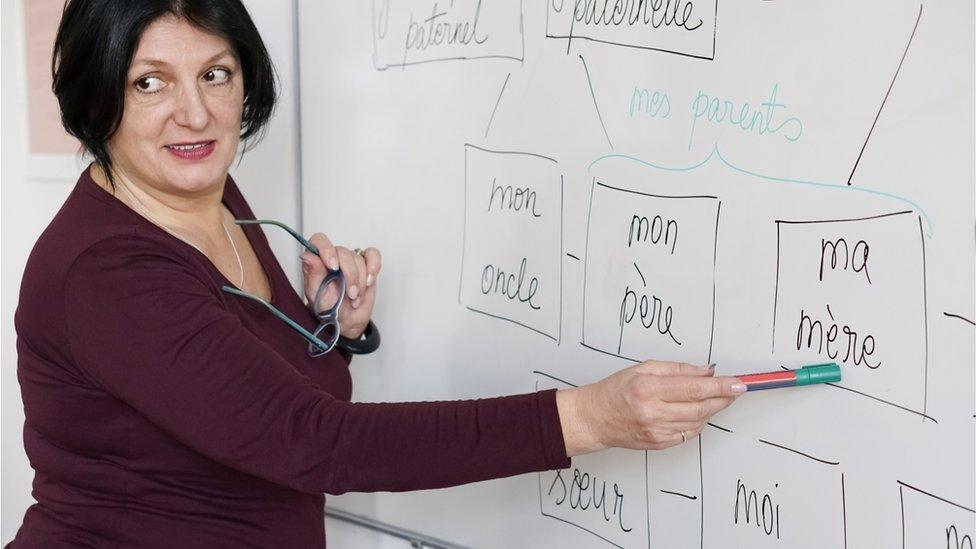NI Education: Compulsory language classes lowest in Europe
- Published

Spanish and Irish overtake French as the most popular languages taken at A-level
Pupils in Northern Ireland are required to learn languages less than those in any other country in Europe.
But Spanish and Irish have overtaken French as the most popular languages taken at A-level.
Those are two of the findings from the British Council's Language Trends 2023 report for Northern Ireland.
It looks at how French, German, Irish, Spanish and other languages are taught in primary and post-primary schools.
Its findings are based on responses from 82 primary school principals and more than 1,100 Year Nine post-primary pupils.
About half of the heads (97) of language departments in post-primary schools also contributed to the study.
Learning a second language is not compulsory for pupils in primary schools in Northern Ireland.
It is the only part of the UK where there is no requirement to teach primary pupils an additional language.
During the Covid pandemic, the British Council found that language learning in primaries had "all but collapsed".
'Earlier exposure better'
But the 2023 trends report said that about half of primary headteachers who responded said they did teach an additional language, with Spanish the most popular.
Some primary principals told the report's authors why they thought languages should be taught to their pupils.
"Having taught in Spain I have seen first-hand how young children can very easily pick up a second language," one said.
"The earlier the exposure to languages the better," another quoted in the report said.
Overall, however, the report said: "Northern Ireland thus has the shortest time for compulsory language learning of any country in the continent of Europe, despite its neighbours in Great Britain and Ireland making languages in primary schools a priority.
"Further, there is no government guidance on how much time should be spent on language learning.
"The flexibility of interpretation affords individual school principals autonomy to decide how much time is allocated for language learning."
Dr Ian Collen, lead researcher of the report and senior lecturer in modern languages education at Queen's University, said there was a huge divide between selective grammar schools and non-selective secondary schools.
"Our data would show that just 16% - that's less than one in five - in non-selective secondary schools are currently studying a language for GCSE," he told BBC News NI's Good Morning Ulster programme.
"Eleven non-selective schools told us that they have no pupils that are studying a language for GCSE.
"That contrasts with the grammar sector where we see 75% of pupils studying a language for GCSE."

Studying a language is not compulsory in Northern Ireland after the age of 14
He added: "Other UK jurisdictions are currently investing very heavily in language learning.
"When we compare that to here in Northern Ireland we have no investment by our local government in language learning and we have very poor outcomes when it comes to uptake for languages at key transition points."
In the survey of Year Nine pupils in post-primaries, the majority said they liked learning languages.
But that enthusiasm does not translate into particularly high uptake for languages at GCSE or A-level.
Studying a language is not compulsory in Northern Ireland after the age of 14.
Some teachers told the report's authors that the way exams were set, marked and graded put pupils off taking languages at GCSE and A-level.
The exams board CCEA has previously investigated whether GCSE and A-level languages are marked too severely.
That was in response to concerns from schools in Northern Ireland that it is harder to receive high marks in language exams.
However, the results of that investigation have not yet been published.

Learning French is in decline amongst GCSE students
There has been a dramatic fall in the number of pupils taking French at GCSE over the past two decades.
"French had 13,099 entries in 2002 and 3,151 in 2022; a decline of some 76%," the language trends report said.
GCSE entries in German had also halved between 2002 and 2022, but entries in Spanish had risen and Irish "has been relatively stable".
The picture was similar at A-level with Spanish and Irish more popular than French.
Some post-primaries had stopped offering French at A-level since the last language trends report in 2021.
'Enthusiasm wanes'
But some of the other languages studied in schools in Northern Ireland include Arabic, Mandarin, Polish and Portuguese.
There has also been a growth in the number of pupils in Irish-medium schools in recent years.
"Language Trends Northern Ireland 2023 confirms that young people are enthusiastic to learn languages in the early stages of post-primary education," the report concluded.
"Their enthusiasm tends to wane as they move through the key stages and invariably they cannot see the value of languages for their future career.
"As a society, there is a need to start a serious conversation about languages in primary schools, the range of languages offered and time devoted to languages in post-primary schools."
Some Irish teachers and speakers have previously warned of a "critical decline" in pupils studying Irish and other languages in schools.
They called for Stormont's Department of Education to recommend that all pupils should study a language at GCSE.
Related topics
- Published7 October 2021

- Published2 June 2021
